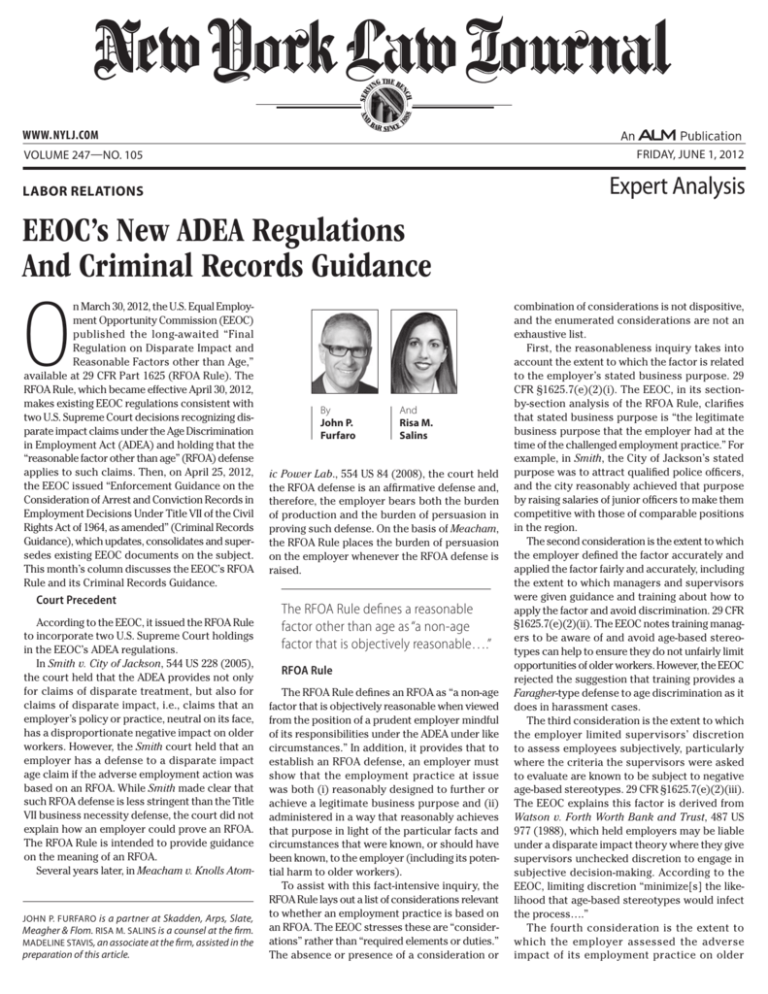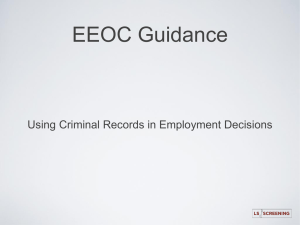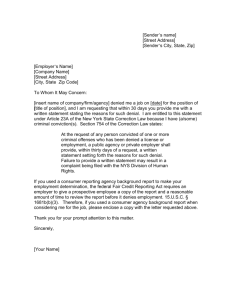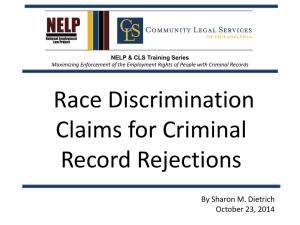
AND
88
8
SER
V
H
NC
THE BE
ING
1
BA
R SINCE
www. NYLJ.com
Volume 247—NO. 105
friday, june 1, 2012
Labor Relations
Expert Analysis
EEOC’s New ADEA Regulations
And Criminal Records Guidance
O
n March 30, 2012, the U.S. Equal Employment Opportunity Commission (EEOC)
published the long-awaited “Final
Regulation on Disparate Impact and
Reasonable Factors other than Age,”
available at 29 CFR Part 1625 (RFOA Rule). The
RFOA Rule, which became effective April 30, 2012,
makes existing EEOC regulations consistent with
two U.S. Supreme Court decisions recognizing disparate impact claims under the Age Discrimination
in Employment Act (ADEA) and holding that the
“reasonable factor other than age” (RFOA) defense
applies to such claims. Then, on April 25, 2012,
the EEOC issued “Enforcement Guidance on the
Consideration of Arrest and Conviction Records in
Employment Decisions Under Title VII of the Civil
Rights Act of 1964, as amended” (Criminal Records
Guidance), which updates, consolidates and supersedes existing EEOC documents on the subject.
This month’s column discusses the EEOC’s RFOA
Rule and its Criminal Records Guidance.
Court Precedent
According to the EEOC, it issued the RFOA Rule
to incorporate two U.S. Supreme Court holdings
in the EEOC’s ADEA regulations.
In Smith v. City of Jackson, 544 US 228 (2005),
the court held that the ADEA provides not only
for claims of disparate treatment, but also for
claims of disparate impact, i.e., claims that an
employer’s policy or practice, neutral on its face,
has a disproportionate negative impact on older
workers. However, the Smith court held that an
employer has a defense to a disparate impact
age claim if the adverse employment action was
based on an RFOA. While Smith made clear that
such RFOA defense is less stringent than the Title
VII business necessity defense, the court did not
explain how an employer could prove an RFOA.
The RFOA Rule is intended to provide guidance
on the meaning of an RFOA.
Several years later, in Meacham v. Knolls Atom-
JOHN P. FURFARO is a partner at Skadden, Arps, Slate,
Meagher & Flom. RISA M. SALINS is a counsel at the firm.
MADELINE STAVIS, an associate at the firm, assisted in the
preparation of this article.
By
John P.
Furfaro
And
Risa M.
Salins
ic Power Lab., 554 US 84 (2008), the court held
the RFOA defense is an affirmative defense and,
therefore, the employer bears both the burden
of production and the burden of persuasion in
proving such defense. On the basis of Meacham,
the RFOA Rule places the burden of persuasion
on the employer whenever the RFOA defense is
raised.
The RFOA Rule defines a reasonable
factor other than age as “a non-age
factor that is objectively reasonable….”
RFOA Rule
The RFOA Rule defines an RFOA as “a non-age
factor that is objectively reasonable when viewed
from the position of a prudent employer mindful
of its responsibilities under the ADEA under like
circumstances.” In addition, it provides that to
establish an RFOA defense, an employer must
show that the employment practice at issue
was both (i) reasonably designed to further or
achieve a legitimate business purpose and (ii)
administered in a way that reasonably achieves
that purpose in light of the particular facts and
circumstances that were known, or should have
been known, to the employer (including its potential harm to older workers).
To assist with this fact-intensive inquiry, the
RFOA Rule lays out a list of considerations relevant
to whether an employment practice is based on
an RFOA. The EEOC stresses these are “considerations” rather than “required elements or duties.”
The absence or presence of a consideration or
combination of considerations is not dispositive,
and the enumerated considerations are not an
exhaustive list.
First, the reasonableness inquiry takes into
account the extent to which the factor is related
to the employer’s stated business purpose. 29
CFR §1625.7(e)(2)(i). The EEOC, in its sectionby-section analysis of the RFOA Rule, clarifies
that stated business purpose is “the legitimate
business purpose that the employer had at the
time of the challenged employment practice.” For
example, in Smith, the City of Jackson’s stated
purpose was to attract qualified police officers,
and the city reasonably achieved that purpose
by raising salaries of junior officers to make them
competitive with those of comparable positions
in the region.
The second consideration is the extent to which
the employer defined the factor accurately and
applied the factor fairly and accurately, including
the extent to which managers and supervisors
were given guidance and training about how to
apply the factor and avoid discrimination. 29 CFR
§1625.7(e)(2)(ii). The EEOC notes training managers to be aware of and avoid age-based stereotypes can help to ensure they do not unfairly limit
opportunities of older workers. However, the EEOC
rejected the suggestion that training provides a
Faragher-type defense to age discrimination as it
does in harassment cases.
The third consideration is the extent to which
the employer limited supervisors’ discretion
to assess employees subjectively, particularly
where the criteria the supervisors were asked
to evaluate are known to be subject to negative
age-based stereotypes. 29 CFR §1625.7(e)(2)(iii).
The EEOC explains this factor is derived from
Watson v. Forth Worth Bank and Trust, 487 US
977 (1988), which held employers may be liable
under a disparate impact theory where they give
supervisors unchecked discretion to engage in
subjective decision-making. According to the
EEOC, limiting discretion “minimize[s] the likelihood that age-based stereotypes would infect
the process….”
The fourth consideration is the extent to
which the employer assessed the adverse
impact of its employment practice on older
friday, june 1, 2012
workers. 29 CFR §1625.7(e)(2)(iv). The EEOC
emphasizes the RFOA defense is less stringent
than the Title VII business necessity defense,
and what an employer reasonably should do to
assess impact depends on the facts of the situation. The EEOC makes clear that if an employer
already assesses race- and sex-based impact, it
would be unreasonable to not likewise assess
age-based impact. At the same time, it states a
smaller employer that does not conduct impact
analyses may still be able to show its RIF decisions were reasonable even if it did not conduct
a formal disparate impact analysis relating to
the RIF.
The final enumerated consideration is the
degree of harm to individuals within the protected age group, in terms of both the extent of
injury and the numbers of persons adversely
affected, and the extent to which the employer
took steps to reduce the harm, in light of the
burden of undertaking such steps. 29 CFR
§1625.7(e)(2)(v). The EEOC explains “the more
severe the harm, the greater the care that ought
to be exercised.”
Notably, while the EEOC clearly states the RFOA
defense does not require an employer to adopt
the least discriminatory alternative (a requirement
of the Title VII business necessity defense), the
EEOC maintains a factor might not be reasonable
if the employer ignored an effective alternative
with a reduced impact.
Public Reactions
How courts will interpret the new ADEA regulations remains to be seen, but business groups are
criticizing the RFOA Rule for making it far more
difficult for employers to successfully assert
the RFOA defense than before. For example,
Michael Eastman, executive director for labor
law policy at the U.S. Chamber of Commerce,
stated the new regulations “represent an attack
on employers’ subjective decision-making and
will require employers to undertake costly disparate impact analyses for virtually every employment decision.” “EEOC Issues Final Rule Under
ADEA on Defense to Disparate Impact Claims,”
Daily Lab Rep (BNA) No 61, at AA-1 (March 29,
2012).
On the other hand, the American Association of Retired Persons (AARP) welcomed the
RFOA Rule, stating by defining “reasonable” in
the context of the RFOA defense, the rule will
“encourage employers to be more diligent at the
front end and to examine whether seemingly
neutral practices have a discriminatory impact
on older workers….” Id.
Criminal Records
While Title VII does not prohibit an employer from requiring applicants or employees to
provide information about arrests, convictions
or incarceration, employers may violate Title
VII through the use of such records. The EEOC
issued the Criminal Records Guidance to con-
solidate and update its previous guidance documents in this area, last issued 20 years ago. The
EEOC said new guidance was needed as recent
studies have shown disproportionately high conviction rates of African-American and Hispanic
men. In addition, technological advances have
made criminal history information more accessible to employers.
While the Criminal Records Guidance provides more in-depth analysis, the EEOC emphasizes that it has not made significant changes
in its long-standing policy on the use of criminal records and Title VII. The EEOC advises
employers that there is Title VII disparate
treatment liability where the evidence shows
that a covered employer rejected a minority
job applicant based on a criminal record but
hired a similarly situated white applicant with
a comparable criminal record. Alternatively, an
employer will be liable under a disparate impact
theory if an employer’s practice of disqualifying
applicants with a criminal record disproportionately screens out a Title VII-protected group
and the employer does not demonstrate that
the practice is job-related for the positions in
question and consistent with business necessity. The Criminal Records Guidance highlights
the EEOC’s concern that exclusions of candidates with criminal records are likely to have a
disparate impact on a protected class because
national data show that minorities are arrested
and incarcerated at disproportionate rates.
Business Necessity
If a plaintiff shows the employer’s criminal
background check has a disparate impact on a
protected class, the burden shifts to the employer to show its practice of excluding applicants
on the basis of a criminal background is jobrelated and consistent with business necessity.
The Criminal Records Guidance contemplates
and explores two ways for employers to meet the
business necessity defense. First, an employer
may validate the criminal conduct screen in
accordance with the Uniform Guidance on
Employee Selection Procedures (if data about
criminal conduct as related to subsequent work
performance is available). See 29 CFR §1607.5.
Alternatively, the employer can conduct a “targeted screen” by considering the following three
factors identified in Green v. Missouri Pacific
Railroad, 523 F2d 1290 (8th Cir 1975): (i) the
nature and gravity of the offense or conduct;
(ii) the time that has passed since the offense
or conduct and/or completion of the sentence;
and (iii) the nature of the job held or sought.
If the Green factors operate to exclude an
applicant, the Criminal Records Guidance states
that an “individualized assessment” can help
employers avoid Title VII liability by allowing
them to consider more complete information
on the individual applicant, such as employment history before and after the offense and
rehabilitation efforts. The applicant should be
informed he may be excluded based on criminal conduct and then have the opportunity to
explain the circumstances and demonstrate that
the exclusion should not apply.
The Criminal Records Guidance distinguishes
between arrests and convictions. Because an
arrest is “not proof of criminal conduct,” a policy
excluding applicants based solely on arrest is not
job-related and consistent with business necessity. However, it is permissible for an employer
to consider the conduct underlying the arrest. In
contrast, an employer may rely on a conviction as
proof the applicant engaged in certain conduct.
Nevertheless, the EEOC recommends that inquiries about convictions be limited to convictions
for which exclusion would be job-related for the
position in question and consistent with business
necessity.
Finally, the Criminal Records Guidance
acknowledges some statutes and regulations
prohibit individuals with certain convictions
from holding certain positions. While compliance with federal statutes and regulations is
a defense to a Title VII charge, it is the EEOC’s
position that compliance with state or local
laws or regulations will not provide a Title VII
defense if the practice is not job-related or
consistent with business necessity.
Best Practices
The Criminal Records Guidance offers best
practices for employers who are considering criminal record information when making
employment decisions. The EEOC recommends
eliminating policies totally excluding people
based on any criminal record, developing a
narrowly tailored written policy for screening
applicants for criminal conduct, and limiting
inquiries regarding criminal records to records
for which exclusion would be job-related for
the position in question and consistent with
business necessity.
Reprinted with permission from the June 1, 2012 edition of the NEW YORK LAW
JOURNAL © 2012 ALM Media Properties, LLC. All rights reserved. Further duplication
without permission is prohibited. For information, contact 877-257-3382 or reprints@alm.
com. # 070-06-12-04









